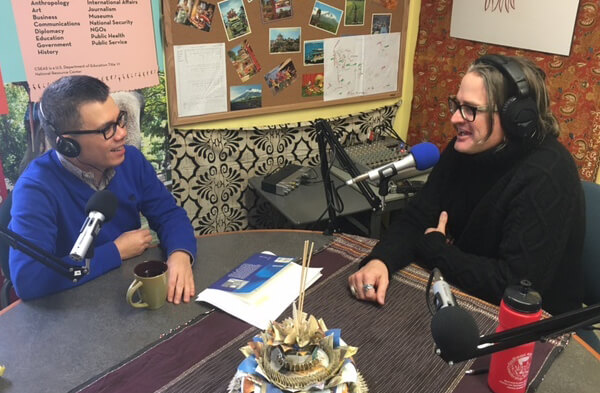 NIU’s Center for Southeast Asian Studies is enlarging its global footprint with a new educational podcast, “Southeast Asia Crossroads,” a twice-monthly series that will showcase Southeast Asian expertise from around the world.
NIU’s Center for Southeast Asian Studies is enlarging its global footprint with a new educational podcast, “Southeast Asia Crossroads,” a twice-monthly series that will showcase Southeast Asian expertise from around the world.
Center for Southeast Asian Studies (CSEAS) Assistant Director and Associate History Professor Eric Jones will moderate the series with other CSEAS associates occasionally stepping in. Guests will be drawn from the Center’s roster of Friday lecture speakers, faculty associates and affiliates, as well as visiting Southeast Asia experts. September’s podcasts include an interview with University of Leeds political scientist Duncan McCargo and an interview about reverse glass painting with Center for Burma Studies Director Catherine Raymond and graduate Research Assistant Carmin Berchiolly. Other guests for the series reflect the interdisciplinary nature of area studies, from art history and anthropology to political science and literature.
While Jones is recording most sessions in a studio set up he rigged at CSEAS, he has corralled a temporary space at the Holmes Student Center to capture interviews with experts from around the world coming to NIU for the Oct. 6–9 International Burma Studies Conference.
What Jones hopes will distinguish Southeast Asia Crossroads is its conversational format, sometimes with more than one guest and host in the mix, and including artists and musicians in addition to scholars. “First and foremost, we are an educational podcast, but we strive to be engaging and entertaining,” he says. “Some educational podcasts just set up a microphone at a traditional lecture and that’s the podcast. There’s nothing wrong with that, but it doesn’t take advantage of some of the dynamic content abilities of this new medium.”
Jones sees the Center’s new venture as a natural extension of the CSEAS mission as a U.S. Department of Education Title VI National Resource Center for Southeast Asian studies. But he is most excited about the prospect of drawing in a new audience.
“A podcast allows us to greatly expand our reach, pushing and broadcasting good Southeast Asia content as a leading center,” he says. “Podcasts are the future of media. Last month, roughly the same number of people listened to a podcast and used Twitter. But in many ways, it’s the opposite of the 140-character message, it’s a deep dive into a specific topic.”
With that kind of depth, Jones is convinced that Southeast Asia Crossroads will become a destination for listeners around the world. “Budding students of Southeast Asia can learn to rely on it for important educational content. Experienced Southeast Asia hands will be able to keep a pulse on the state of the field. Casual listeners, lifelong learners and comparative analysts can find great topics about a region they want to know more about,” he says.
With barely any publicity so far, he notes, Southeast Asia Crossroads has been downloaded 56 times by listeners from the U.S. to Belgium, Germany and Mexico. Podcasts are available on Soundcloud at soundcloud.com/seacrossroads.
